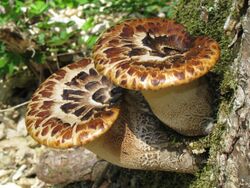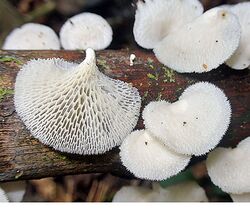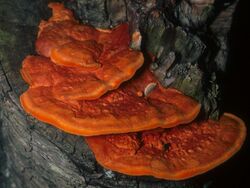Biology:Polyporaceae
| Polyporaceae | |
|---|---|

| |
| Dryad's saddle (Cerioporus squamosus) | |
| Scientific classification | |
| Domain: | Eukaryota |
| Kingdom: | Fungi |
| Division: | Basidiomycota |
| Class: | Agaricomycetes |
| Order: | Polyporales |
| Family: | Polyporaceae Fr. ex Corda (1839)[1] |
| Type genus | |
| Polyporus P.Micheli ex Adans. (1763)
| |
| Synonyms[2] | |
| |
The Polyporaceae (/pɔːliːpoʊreɪsiˌaɪ, -siːˌiː/) are a family of poroid fungi belonging to the Basidiomycota. The flesh of their fruit bodies varies from soft (as in the case of the dryad's saddle illustrated) to very tough. Most members of this family have their hymenium (fertile layer) in vertical pores on the underside of the caps, but some of them have gills (e.g. Panus) or gill-like structures (such as Daedaleopsis, whose elongated pores form a corky labyrinth). Many species are brackets, but others have a definite stipe – for example, Polyporus badius.
Most of these fungi have white spore powder but members of the genus Abundisporus have colored spores and produce yellowish spore prints. Cystidia are absent.
Taxonomy
In his 1838 work Epicrisis Systematis Mycologici seu Synopsis Hymenomycetum, Elias Magnus Fries introduced the "Polyporei".[3] August Corda published the name validly the following year, retaining Fries's concept.[1] American mycologist William Alphonso Murrill, in a series of publications in the early 1900s, classified the polypores into a more organized family of 78 genera, including 29 that were monotypic, and 39 that were new to science.[4] Around the same time as Murrill, Curtis Gates Lloyd devoted considerable effort in sorting polypore taxonomy, and amassed a large and diverse collection of fruit bodies from around the world.[5] In his 1953 monograph The Polyporaceae of the European U.S.S.R. and Caucasia, Apollinarii Semenovich Bondartsev included 54 genera in the Polyporaceae, which he further divided into five subfamilies and 10 tribes.[6] Several works contributing to the systematics of the Polyporaceae were published in the following decades, including Marinus Anton Donk (1960, 1964),[7][8] Gordon Heriot Cunningham (1965),[9] and David Pegler (1973).[10]
Genera
(As of April 2018), Index Fungorum accepts 114 genera and 1621 species in the Polyporaceae:[11]
- Abundisporus Ryvarden (1999);[12] 7 species
- Amyloporia Singer (1944);[13] 5 species
- Amyloporiella A.David & Tortič (1984); 1 species
- Atroporus Ryvarden (1973); 3 species
- Aurantiporus Murrill (1905);[14] 5 species
- Australoporus P.K.Buchanan & Ryvarden (1988);[15] 1 species
- Austrolentinus Ryvarden (1991);[16] 1 species
- Cellulariella Zmitr. & Malysheva (2014); 2 species
- Cerrena Gray (1821); 7 species
- Cerarioporia F.Wu, L.W.Zhou & Jing Si;[17] 1 species
- Colospora Miettinen & Spirin (2015);[18] 1 species
- Coriolopsis Murrill (1905); 21 species
- Crassisporus B.K. Cui & Xing Ji (2019); 4 species
- Cryptomphalina R.Heim (1966);[19] 1 species
- Cryptoporus (Peck) Shear (1902); 2 species
- Cystidiophorus Bondartsev & Ljub. (1963);[20] 1 species
- Daedaleopsis J.Schröt. (1888); 9 species
- Datronia Donk (1966); 8 species
- Datroniella B.K.Cui, Hai J.Li & Y.C.Dai (2014); 5 species
- Dentocorticium (Parmasto) M.J.Larsen & Gilb. (1974); 7 species
- Dextrinoporus H.S.Yuan (2018);[21] 1 species
- Dichomitus D.A.Reid (1965); 24 species
- Diplomitoporus Domański (1970); 20 species
- Earliella Murrill (1905); 1 species
- Echinochaete D.A.Reid (1963); 5 species
- Epithele (Pat.) Pat. (1900); 24 species
- Epithelopsis Jülich (1976); 2 species
- Erastia Niemelä & Kinnunen (2005); 1 species
- Faerberia Pouzar (1981); 1 species
- Favolus Fr. (1828); 25 species
- Flammeopellis Y.C.Dai, B.K.Cui & C.L.Zhao (2014);[22] 1 species
- Fomes (Fr.) Fr. (1849); 59 species
- Funalia Pat. (1900); 7 species
- Fuscocerrena Ryvarden (1982); 1 species
- Globifomes Murrill (1904); 1 species
- Grammothele Berk. & M.A.Curtis (1868); 19 species
- Grammothelopsis Jülich (1982); 7 species
- Hapalopilus P.Karst. (1881); 15 species
- Haploporus Bondartsev & Singer (1944); 6 species
- Hexagonia Fr. (1836); 41 species
- Hymenogramme Mont. & Berk. (1844); 1 species
- Laccocephalum McAlpine & Tepper (1895); 5 species
- Laetifomes T.Hatt. (2001); 1 species
- Leifiporia Y.C.Dai, F.Wu & C.L.Zhao (2016);[23] 2 species
- Leiotrametes Welti & Courtec. (2012); 2 species
- Lentinus Fr. (1825); 120 species
- Lenzites Fr. (1836); 25 species
- Leptoporus Quél. (1886); 12 species
- Lignosus Lloyd ex Torrend (1920); 8 species
- Lithopolyporales R.K.Kar, N.Sharma, A.Agarwal & R.Kar (2003); 1 species
- Lloydella Bres. (1901); 3 species
- Lopharia Kalchbr. & MacOwan (1881); 15 species
- Loweporus J.E.Wright (1976); 8 species
- Macrohyporia I.Johans. & Ryvarden (1979); 3 species
- Megasporia B.K.Cui, Y.C.Dai & Hai J.Li (2013);[24] 7 species
- Megasporoporia Ryvarden & J.E.Wright (1982); 4 species[25]
- Megasporoporiella B.K.Cui, Y.C.Dai & Hai J.Li (2013);[24] 5 species
- Melanoderma B.K.Cui & Y.C.Dai (2011); 2 species
- Melanoporella Murrill (1907); 1 species
- Microporellus Murrill (1905); 23 species
- Microporus P.Beauv. (1805); 12 species
- Mollicarpus Ginns (1984); 1 species[26]
- Mycobonia Pat. (1894); 1 species
- Myriothele Nakasone (2013);[27] 1 species
- Navisporus Ryvarden (1980); 6 species[28]
- Neodatronia B.K.Cui, Hai J.Li & Y.C.Dai (2014); 2 species[29]
- Neodictyopus Palacio, Robledo, Reck & Drechsler-Santos; 3 species[30]
- Neofavolus Sotome & T.Hatt. (2013); 4 species[31]
- Neofomitella Y.C.Dai, Hai J.Li & Vlasák (2015); 3 species
- Nigrofomes Murrill (1904); 2 species
- Pachykytospora Kotl. & Pouzar (1963); 3 species[32]
- Panus Fr. (1838); 40 species
- Perenniporia Murrill (1942); 100 species
- Perenniporiella Decock & Ryvarden (2003); 5 species
- Perenniporiopsis C.L.Zhao (2017); 1 species[33]
- Phaeotrametes Lloyd ex J.E.Wright (1966); 1 species
- Piloporia Niemelä (1982); 2 species
- Podofomes Pouzar (1966); 3 species
- Polyporus P.Micheli ex Adans. (1763); 279 species
- Porogramme (Pat.) Pat. (1900); 7 species
- Poronidulus Murrill (1904); 2 species
- Pseudofavolus Pat. (1900); 6 species
- Pseudopiptoporus Ryvarden (1980); 2 species[28]
- Pseudomegasporoporia 1 species[34]
- Pycnoporus P.Karst. (1881); 4 species
- Pyrofomes Kotl. & Pouzar (1964); 7 species
- Roseofavolus T.Hatt. (2003);[35] 1 species
- Royoporus A.B.De (1996); 2 species[36]
- Rubroporus Log.-Leite, Ryvarden & Groposo (2002); 2 species[37]
- Ryvardenia Rajchenb. (1994); 2 species[38]
- Sarcoporia P.Karst. (1894); 3 species
- Skeletocutis Kotl. & Pouzar (1958); 43 species
- Sparsitubus L.W.Hsu & J.D.Zhao (1980); 1 species[39]
- Spongipellis Pat. (1887); 9 species
- Stiptophyllum Ryvarden (1973); 1 species[40]
- Thermophymatospora Udagawa, Awao & Abdullah (1986); 1 species
- Tinctoporellus Ryvarden (1979); 4 species[41]
- Trametes Fr. (1836); 195 species
- Trametopsis Tomšovský (2008); 1 species[42]
- Tyromyces P.Karst. (1881); 119 species
- Truncospora Pilát (1953); 10 species
- Vanderbylia D.A.Reid (1973); 7 species[43]
- Wolfiporia Ryvarden & Gilb. (1984); 6 species[44]
- Xerotus Fr. (1828); 16 species
- Yuchengia B.K.Cui & Steffen (2013);[45] 1 species
In a proposed family-level classification of the Polyporales based on molecular phylogenetics, Alfredo Justo and colleagues propose synonymizing the Ganodermataceae with the Polyporaceae, and accept 44 genera in this family: Abundisporus, Amauroderma, Cerarioporia, Colospora, Cryptoporus, Datronia, Datroniella, Dendrodontia, Dentocorticium, Dichomitus, Donkioporia, Earliella, Echinochaete, Epithele, Favolus, Fomes, Fomitella, Ganoderma, Grammothele, Grammothelopsis, Hexagonia, Haploporus, Hornodermoporus, Lentinus, Lignosus, Lopharia, Megasporia, Megasporoporia, Melanoderma, Microporellus, Microporus, Neodatronia, Neofavolus, Pachykytospora, Perenniporia, Perenniporiella, Pseudofavolus, Pyrofomes, Tinctoporellus, Tomophagus, Trametes, Truncospora, Vanderbylia, and Yuchengia.[2]
References
- ↑ 1.0 1.1 Corda, A.C.J. (1839). Icones fungorum hucusque cognitorum. 3. p. 49. http://bibdigital.rjb.csic.es/ing/Libro.php?Libro=1811&Pagina=57.
- ↑ 2.0 2.1 Justo, Alfredo; Miettinen, Otto; Floudas, Dimitrios; Ortiz-Santana, Beatriz; Sjökvist, Elisabet; Lindner, Daniel; Nakasone, Karen; Niemelä, Tuomo et al. (2017). "A revised family-level classification of the Polyporales (Basidiomycota)". Fungal Biology 121 (9): 798–824. doi:10.1016/j.funbio.2017.05.010. PMID 28800851.
- ↑ Fries, E. M. (1838) (in la). Epicrisis Systematis Mycologici: Seu Synopsis Hymenomycetum. 1–2. Uppsala, Sweden: Regiae Academiae Typographia. p. 408. https://archive.org/stream/bub_gb_fUU-AAAAcAAJ#page/n423/mode/2up.
- ↑ For example:
- Murrill, William A. (1902). "The Polyporaceae of North America. I. The genus Ganoderma". Bulletin of the Torrey Botanical Club 29 (10): 599–608. doi:10.2307/2478682. https://www.biodiversitylibrary.org/page/719533.
- Murrill, William A. (1903). "The Polyporaceae of North America. II. The genus Pyropolyporus". Bulletin of the Torrey Botanical Club 30 (2): 109–120. doi:10.2307/2478882. https://www.biodiversitylibrary.org/page/712786.
- Murrill, William A. (1903). "The Polyporaceae of North America.-III. The genus Fomes". Bulletin of the Torrey Botanical Club 30 (4): 225–232. doi:10.2307/2478780. https://www.biodiversitylibrary.org/page/712917.
- Murrill, William A. (1903). "The Polyporaceae of North America.-IV. The genus Elfvingia". Bulletin of the Torrey Botanical Club 30 (5): 296–301. doi:10.2307/2478555. https://www.biodiversitylibrary.org/page/712996.
- Murrill, William A. (1903). "The Polyporaceae of North America.-V. The genera Cryptoporus, Piptoporus, Scutiger and Porodiscus". Bulletin of the Torrey Botanical Club 30 (8): 423–434. doi:10.2307/2478728. https://www.biodiversitylibrary.org/page/713143.
- Murrill, William A. (1904). "The Polyporaceae of North America-VI. The genus Polyporus". Bulletin of the Torrey Botanical Club 31 (1): 29–44. doi:10.2307/2478751. https://www.biodiversitylibrary.org/page/13175364.
- Murrill, William A. (1904). "The Polyporaceae of North America-VII. The genera Hexagona, Grifola, Romellia, Coltricia and Coltriciella". Bulletin of the Torrey Botanical Club 31 (6): 325–348. doi:10.2307/2478798. https://www.biodiversitylibrary.org/page/13175712.
- Murrill, William A. (1904). "The Polyporaceae of North America-VIII. Hapalopilus, Pycnoporus, and new monotypic genera". Bulletin of the Torrey Botanical Club 31 (8): 415–428. doi:10.2307/2478892. https://www.biodiversitylibrary.org/page/13175820.
- Murrill, William A. (1904). "The Polyporaceae of North America-IX. Inonotus, Sesia and monotypic genera". Bulletin of the Torrey Botanical Club 31 (11): 593–610. doi:10.2307/2478612. https://www.biodiversitylibrary.org/page/13176033.
- Murrill, William A. (1905). "The Polyporaceae of North America-X. Agaricus, Lenzites, Cerrena, and Favolus". Bulletin of the Torrey Botanical Club 32 (2): 83–103. doi:10.2307/2478510. https://www.biodiversitylibrary.org/page/13413414.
- Murrill, William A. (1905). "The Polyporaceae of North America-XI. A synopsis of the brown pileate species". Bulletin of the Torrey Botanical Club 32 (7): 353–371. doi:10.2307/2478499. https://www.biodiversitylibrary.org/page/13413740.
- Murrill, William A. (1905). "The Polyporaceae of North America-XII. A synopsis of the white and bright-colored pileate species". Bulletin of the Torrey Botanical Club 32 (9): 469–493. doi:10.2307/2478463. https://www.biodiversitylibrary.org/page/13413873.
- Murrill, William A. (1905). "The Polyporaceae of North America-XIII. The described species of Bjerkandera, Trametes, and Coriolus". Bulletin of the Torrey Botanical Club 32 (12): 633–656. doi:10.2307/2478704. https://www.biodiversitylibrary.org/page/13414065.
- Murrill, William A. (1907). North American flora 9. Part 1. New York: The New York Botanical Garden.
- Murrill, William A. (1908). North American flora 9. Part 2. New York: The New York Botanical Garden.
- Murrill, William A. (1905). "The Polyporaceae of North America: XII. A synopsis of the white and bright-colored pileate species". Bulletin of the Torrey Botanical Club 32 (9): 469–494. doi:10.2307/2478463.
- ↑ Lowe, Josiah L. (1963). "The Polyporaceae of the world". Mycologia 55 (1): 1–12. doi:10.2307/3756376. http://www.cybertruffle.org.uk/cyberliber/59350/0055/001/0001.htm.
- ↑ Bondartsev, A.S. (1953). The Polyporaceae of the European USSR and Caucasia. Moscow: Israel Program for Scientific Translations.
- ↑ Donk, M.A. (1960). "The generic names proposed for Polyporaceae". Persoonia 1 (2): 173–302. http://www.cybertruffle.org.uk/cyberliber/61056/0001/002/0173.htm.
- ↑ Donk, M.A. (1964). "A conspectus of the families of Aphyllophorales". Persoonia 3 (2): 199–324. http://www.cybertruffle.org.uk/cyberliber/61056/0003/002/0199.htm.
- ↑ Cunningham, G.H. (1965). "Polyporaceae of New Zealand". New Zealand Department of Scientific and Industrial Research Bulletin 164: 1–304.
- ↑ Pegler, D.N. (1973). "Aphyllophorales IV. Poroid families". The Fungi IV-B an advance treatise. IV B. New York and London: Academic press. pp. 397–420.
- ↑ Kirk, P.M.. "Species Fungorum (version 28th March 2018). In: Species 2000 & ITIS Catalogue of Life". http://www.catalogueoflife.org/col/browse/tree/id/2edbee0c1fe032132198785a4d64aad9.
- ↑ Ryvarden, Leif (1998). "African polypores: A review". Belgian Journal of Botany 131: 150–155.
- ↑ Singer, Rolf (1944). "Notes on taxonomy and nomenclature of the polypores". Mycologia 36 (1): 65–69. doi:10.2307/3754880. http://www.cybertruffle.org.uk/cyberliber/59350/0036/001/0065.htm.
- ↑ Murrill, William Alphonso (1905). "The Polyporaceae of North America: XII. A synopsis of the white and bright-colored pileate species". Bulletin of the Torrey Botanical Club 32 (9): 469–494. doi:10.2307/2478463.
- ↑ Buchanan, P.K.; Ryvarden, L. (1988). "Type studies in the Polyporaceae – 18. Species described by G.H. Cunningham". Mycotaxon 31 (1): 1–38. http://www.cybertruffle.org.uk/cyberliber/59575/0031/001/0001.htm.
- ↑ Ryvarden, Leif (1991). Genera of Polypores, Nomenclature and Taxonomy. Synopsis Fungorum. 5. p. 115. ISBN 978-8290724103.
- ↑ Wu, Fang; Zhou, Li-Wei; Yuan, Yuan; Tian, Xue-Mei; Si, Jing (2016). "Cerarioporia cystidiata gen. et sp. nov. (Polyporales, Basidiomycota) evidenced by morphological characters and molecular phylogeny". Phytotaxa 280 (1): 55–62. doi:10.11646/phytotaxa.280.1.5.
- ↑ Ariyawansa Hiran A. et al. (2015). "Fungal diversity notes 111–252 – taxonomic and phylogenetic contributions to fungal taxa". Fungal Diversity 75 (1): 27–274. doi:10.1007/s13225-015-0346-5. https://hau.collections.crest.ac.uk/9284/1/Mike%20Theodorou%20Fungal%2BDiversity%202%20April.pdf.
- ↑ Heim, R. (1966). "Breves diagnoses latinae novitatum genericarum specificarumque nuper descriptarum". Revue de Mycologie 30: 231–241.
- ↑ Bondartsev, A.; Ljubarsky, L.V. (1963). "Genus novum et species novae Polyporacearum in Oriente extremo inventae". Botanicheskie Materialy Otdela Sporovyh Rastenij Botanicheskogo Instituti Imeni V.L. Komarova 16: 125–133.
- ↑ Yuan, H.S.; Qin, W.M. (2018). "Multiple genes phylogeny and morphological characters reveal Dextrinoporus aquaticus gen. et sp. nov. (Polyporales, Basidiomycota) from southern China". Mycological Progress 17 (6): 773–780. doi:10.1007/s11557-018-1392-7.
- ↑ Chang-Lin Zhao; Xin-Sheng He; Kun-Yuan Wanghe; Bao-Kai Cui; Yu-Cheng Dai (2014). "Flammeopellis bambusicola gen. et. sp. nov. (Polyporales, Basidiomycota) evidenced by morphological characters and phylogenetic analysis". Mycological Progress 13 (3): 771–780. doi:10.1007/s11557-014-0960-8.
- ↑ Zhao, Changlin; Wu, Fang; Dai, Yu-Cheng (2016). "Leifiporia rhizomorpha gen. et sp. nov. and L. eucalypti comb. nov. in Polyporaceae (Basidiomycota)". Mycological Progress 15 (7): 799–808. doi:10.1007/s11557-016-1210-z. https://www.researchgate.net/publication/304454074.
- ↑ 24.0 24.1 Li, Hai-Jiao; Cui, Bao-Kai (2013). "Taxonomy and phylogeny of the genus Megasporoporia and its related genera". Mycologia 105 (2): 368–383. doi:10.3852/12-114. PMID 23099513.
- ↑ Ryvarden, L.; Wright, J.E.; Rajchenberg, M. (1982). "Megasporoporia, a new genus of resupinate polypores". Mycotaxon 16 (1): 172–182. http://www.cybertruffle.org.uk/cyberliber/59575/0016/001/0172.htm.
- ↑ Ginns, J. (1984). "Mollicarpus gen. nov. (Polyporaceae) with notes on Coriolopsis byrsina, Phellinus crocatus, and Polystictus crocatus var. sibiricus". Mycotaxon 19: 71–80. http://www.cybertruffle.org.uk/cyberliber/59575/0019/0071.htm.
- ↑ Nakasone, K.K. (2013). "Taxonomy of Epithele (Polyporales, Basidiomycota)". Sydowia 65: 59–112.
- ↑ 28.0 28.1 Ryvarden, Leif; Johansen, I.. A preliminary polypore flora of East Africa. Oslo: Fungiflora. pp. 443; 523.
- ↑ Li, H.J.; Cui, B.K.; Dai, Y.C. (2014). "Taxonomy and multi-gene phylogeny of Datronia (Polyporales, Basidiomycota)". Persoonia 32: 170–182. doi:10.3767/003158514X681828. PMID 25264389.
- ↑ Palacio, Melissa; Robledo, Gerardo Lucio; Reck, Mateus Arduvino; Grassi, Emanuel; Góes-Neto, Aristóteles; Drechsler-Santos, Elisandro Ricardo (2017). "Decrypting the Polyporus dictyopus complex: Recovery of Atroporus Ryvarden and segregation of Neodictyopus gen. nov. (Polyporales, Basidiomyocta)". PLOS ONE 12 (10): e0186183. doi:10.1371/journal.pone.0186183. PMID 29049417. Bibcode: 2017PLoSO..1286183P.
- ↑ Sotome, Kozue; Akagi, Yasunori; Lee, Su See; Ishikawa, Noemia K.; Hattori, Tsutomu (2013). "Taxonomic study of Favolus and Neofavolus gen. nov. segregated from Polyporus (Basidiomycota, Polyporales)". Fungal Diversity 58 (1): 245–266. doi:10.1007/s13225-012-0213-6.
- ↑ Kotlába, F.; Pouzar, Z. (1963). "A new genus of the Polypores –Pachykytospora gen. nov.". Ceská Mykologie 17 (1): 27–34.
- ↑ Wu, Zi-Qiang; Liu, Wei-Li; Wang, Zheng-Hui; Zhao, Chang-Lin (2017). "Perenniporiopsis, a new polypore genus segregated from Perenniporia (Polyporales)". Cryptogamie, Mycologie 38 (3): 285–299. doi:10.7872/crym/v38.iss3.2017.285.
- ↑ Ji, Xiao-Hong; Wu, Fang (2017). "Pseudomegasporoporia neriicola gen. et sp. nov. (Polyporaceae, Basidiomycota) from East Asia". Nova Hedwigia 105 (3–4): 435–443. doi:10.1127/nova_hedwigia/2017/0424.
- ↑ Hattori, Tsutomu (2003). "Type studies of the polypores described by E.J.H. Corner from Asia and West Pacific Areas. VI. Species described in Tyromyces (3), Cristelloporia, Grifola, Hapalopilus, Heterobasidion, Ischnoderma, Loweporus and Steccherinum". Mycoscience 44 (6): 453–463. doi:10.1007/s10267-003-0139-7.
- ↑ De, A.B. (1996). "Royoporus – a new genus for Favolus spathulatus". Mycotaxon 60: 143–148. http://www.cybertruffle.org.uk/cyberliber/59575/0060/0143.htm.
- ↑ Loguercio-Leite, Clarice; Ryvarden, Leif; Groposo, Claudia (2002). "Studies in neotropical polypores 16. Rubroporus carneoporis genus & species nova". Mycotaxon 83: 223–227. http://www.cybertruffle.org.uk/cyberliber/59575/0083/0223.htm.
- ↑ Rajchenberg, Mario (1994). "A taxonomic study of the subantarctic Piptoporus (Polyporaceae, Basidiomycetes) I". Nordic Journal of Botany 14 (4): 435–449. doi:10.1111/j.1756-1051.1994.tb00629.x.
- ↑ Xu, L.W.; Zhao, J.D. (1980) (in zh). [A new genus of Polyporaceae from China]. Acta Microbiologica Sinica. 20. pp. 236–239.
- ↑ Ryvarden, L. (1973). "New genera in the Polyporaceae". Norwegian Journal of Botany 20 (1): 1–5.
- ↑ Ryvarden, L. (1979). "Porogramme and related genera". Transactions of the British Mycological Society 73 (3): 9–19. doi:10.1016/s0007-1536(79)80066-2. http://www.cybertruffle.org.uk/cyberliber/59351/0073/001/0009.htm.
- ↑ Tomsovsky, M. (2008). "Molecular phylogeny and taxonomic position of Trametes cervina and description of the new genus Trametopsis". Czech Mycology 60 (1): 1–11. doi:10.33585/cmy.60101.
- ↑ Reid, D.A. (1973). "A reappraisal of type and authentic specimens of Basidiomycetes in the van der Byl herbarium, Stellenbosch". South African Journal of Botany 39 (2): 141–178.
- ↑ Ginns, J. (1984). "New names, new combinations and new synonymy in the Corticiaceae, Hymenochaetaceae and Polyporaceae". Mycotaxon 21: 325–333. http://www.cybertruffle.org.uk/cyberliber/59575/0021/0325.htm.
- ↑ Zhao, Chang-Lin; Cui, Bao-Kai; Steffen, Karl Timo (2013). "Yuchengia, a new polypore genus segregated from Perenniporia (Polyporales, Basidiomycota)". Mycoscience 31 (3): 331–338. doi:10.1111/j.1756-1051.2012.00003.x.
Wikidata ☰ Q658831 entry
 |








